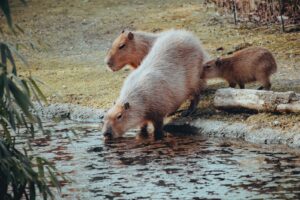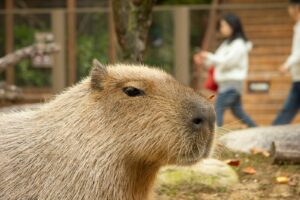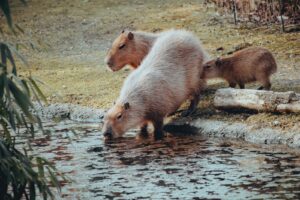The growing trend of keeping capybaras as pets has sparked debate about the ethics and practicality of owning these large rodents. As more people consider bringing a capybara into their home, it’s crucial to understand the complexities involved in their care and the potential impact on both the animal and owner. This unique pet choice raises questions about proper housing, diet, and the legal status of capybara ownership in different regions.
Potential capybara owners need to weigh several factors before making a decision. These include the animal’s need for a swimming pool, specialized veterinary care, and a diet rich in vitamin C. Ethical concerns surrounding the exotic pet trade and capybara domestication also come into play. Additionally, prospective owners must research capybara pet requirements, housing needs, and whether it’s legal to own a capybara in their area, as regulations vary in places like Florida, Texas, and California.
Understanding Capybaras: Natural Habitat and Behavior
Capybaras in the wild
Capybaras are native to South America, inhabiting a diverse range of habitats including forests, savannas, and marshlands. These semi-aquatic mammals are well-adapted to life near water bodies such as rivers, lakes, ponds, and swamps. Their natural range extends across several countries, including Panama, Colombia, Venezuela, Guyana, Peru, Brazil, Paraguay, Northeast Argentina, and Uruguay.
As the largest rodents in the world, capybaras have a unique lifestyle that revolves around water. They can hold their breath underwater for up to 5 minutes, which serves as a crucial survival mechanism. Their bodies are specially designed for aquatic life, with partially webbed feet that help them swim efficiently.
Social structure and needs
Capybaras are highly social animals, living in groups that can range from 10 to 40 individuals. During the dry season, when water sources become scarce, these groups can temporarily swell to as many as 100 members. A typical family unit consists of one dominant male, several females, and their offspring.
Within these groups, a clear hierarchy exists. The dominant male leads the pack, followed by an alpha female. This social structure helps maintain order and protects the family unit. Capybaras communicate through various vocalizations, including barks, whistles, and purrs, which help them stay in touch with each other and alert the group to potential dangers.
Adaptations to semi-aquatic lifestyle
Capybaras have several physical adaptations that make them well-suited to their semi-aquatic habitat. Their eyes, ears, and nostrils are positioned high on their heads, allowing them to remain alert while most of their body is submerged in water. This adaptation has an influence on their survival, as it helps them detect predators such as jaguars, pumas, and caimans while staying hidden.
Their diet primarily consists of grasses and aquatic plants, with an adult capybara consuming up to 6 to 8 pounds of fresh grass daily. During dry seasons or droughts, they adapt their diet to include grains, melons, and squashes.
Capybaras are crepuscular, meaning they are most active during dawn and dusk. They often spend the morning hours resting near the water’s edge and retreat to the water or mud during the hottest part of the day. This behavior helps them regulate their body temperature and avoid predators.
In conclusion, capybaras’ natural habitat and behavior are intricately linked to their semi-aquatic lifestyle and social nature. These unique characteristics have a significant impact on their survival in the wild and pose challenges when considering them as potential pets.
The Exotic Pet Trade: Impact on Capybaras
Sourcing of pet capybaras
The sourcing of capybaras for the pet trade has a significant impact on wild populations. In some regions, capybaras are captured from their natural habitats to meet the growing demand for exotic pets. This practice has an influence on the sustainability of wild capybara populations and raises ethical concerns about the treatment of these animals during capture and transport.
Capturing wild capybaras for various purposes, including the pet trade, presents numerous challenges. The process can be notoriously difficult, as any chemical restraint requires careful consideration. Physical injuries during pursuit and restraint are common, potentially causing trauma to the animals. These risks highlight the need for more humane and controlled methods of sourcing capybaras for the pet trade.
Consequences for wild populations
The exotic pet trade has serious consequences for wild capybara populations. In some areas, uncontrolled exploitation has led to the depletion of capybaras in their natural environment. This decline in population numbers has an impact on the ecological balance of their habitats and may affect other species that depend on capybaras for various ecosystem functions.
The demand for capybara meat, particularly during Easter in some regions, has also contributed to the pressure on wild populations. This dual demand for capybaras as pets and for their meat has intensified the challenges faced by conservation efforts. To address these issues, it is crucial to establish guidelines for sustainable capybara use that guarantee the conservation of their populations.
Ethical concerns of the exotic pet industry
The exotic pet industry raises numerous ethical concerns, particularly regarding the welfare of capybaras. These semi-aquatic rodents have specific needs that are challenging to meet in a domestic setting. They require access to water for swimming, a specialized diet rich in vitamin C, and ample space to roam. Many potential owners may not be prepared to provide these essential elements of capybara care.
Furthermore, capybaras are social animals that thrive in groups. In the wild, they live in herds of up to 30 individuals. Keeping a single capybara as a pet can lead to stress and depression, as they need companionship and social interaction. This raises questions about the ethics of keeping these animals in isolation or in environments that don’t meet their social needs.
The exotic pet trade also has broader implications for wildlife conservation. Poaching from the wild for the pet trade is a serious problem for many endangered species. Even when capybaras are legally obtained, the industry may inadvertently encourage the capture of wild animals, putting pressure on natural populations.
To address these concerns, it’s crucial to consider alternatives to keeping capybaras as pets. Visiting these animals in professional zoos or wildlife sanctuaries, where they can receive proper care and live in more suitable environments, may be a more ethical option for those interested in these fascinating creatures.
Challenges of Domesticating Capybaras
Differences between wild and captive-bred capybaras
Domesticating capybaras presents unique challenges due to their specific needs and natural behaviors. Wild capybaras differ significantly from their captive-bred counterparts in terms of behavior and adaptation to human environments. Studies have shown that wild-caught capybaras tend to be more nervous and shy, often exhibiting flight responses to humans even after years in captivity. This wariness can make it difficult for potential owners to establish a bond with these animals.
Captive-born capybaras, on the other hand, are generally more disposed to handling conditions and appear more docile. However, this doesn’t necessarily mean they make ideal pets. Both wild and captive-bred capybaras require extensive space and specific environmental conditions to thrive, which can be challenging to provide in a domestic setting.
Behavioral issues in captivity
Keeping capybaras as pets can lead to various behavioral issues. These social animals naturally live in groups of 10 to 30 individuals in the wild. When kept in isolation or small numbers, capybaras can become stressed and depressed, which may have an impact on their overall well-being. This social nature makes it necessary for potential owners to consider adopting multiple capybaras, increasing the complexity and cost of care.
Capybaras in captivity may also exhibit aggressive behaviors, especially when competing for resources or establishing dominance hierarchies. Studies have observed that in captive environments, there’s often a monopolization of feeding resources by dominant individuals, leading to increased rates of aggression and mortality. This behavior can be particularly challenging to manage in a domestic setting.
Health concerns specific to captive capybaras
Captive capybaras are prone to several health issues that potential owners must be prepared to address. One of the most significant concerns is vitamin C deficiency, as capybaras cannot synthesize their own vitamin C. This deficiency can lead to scurvy, which has symptoms such as slow growth, hair loss, weak ligaments, bleeding gums, and low bone density. To prevent this, captive capybaras require a daily vitamin C supplement of at least 1,000 mg for an adult.
Dental problems are another common issue in captive capybaras. Their teeth grow continuously, and without proper wear, they can develop painful dental conditions. Providing appropriate chewing materials and a diet that promotes natural tooth wear is crucial for maintaining dental health.
Respiratory infections and infestations with mites or lice are also concerns for capybaras kept in captivity. Regular health checks and access to specialized veterinary care are essential for managing these potential health issues.
In conclusion, while capybaras may seem appealing as exotic pets, the challenges of domestication are significant. Potential owners must carefully consider the extensive space requirements, social needs, behavioral issues, and health concerns before deciding to keep a capybara as a pet. In many cases, these animals are better suited to professional care in zoos or wildlife sanctuaries where their complex needs can be fully met.
Responsible Ownership: Is it Possible?
Creating an appropriate captive environment
Responsible ownership of a capybara as a pet requires creating an environment that closely mimics their natural habitat. These semi-aquatic rodents need a spacious enclosure with access to a swimming pool or pond. The minimum recommended space for a pair of capybaras is approximately 250 square feet, with a pool at least 3 feet deep. This allows them to engage in their natural behaviors, such as swimming and grazing.
The enclosure should include a variety of elements to enrich their lives, such as logs, platforms, and shaded areas. Providing a mud wallow has an influence on their well-being, as rolling in mud is a natural behavior that helps them relax and regulate their body temperature. It’s crucial to ensure that the enclosure has both sunny and shaded areas to allow capybaras to thermoregulate effectively.
Meeting the complex needs of capybaras
Capybaras have specific dietary requirements that must be met to maintain their health. Their diet should primarily consist of grasses and hay, supplemented with leafy greens and a limited amount of fruits. It’s essential to provide a source of vitamin C, as capybaras cannot synthesize this vital nutrient on their own. A daily supplement of at least 1,000 mg of vitamin C is recommended for adult capybaras.
Regular veterinary care is crucial for capybaras, but finding a veterinarian experienced in exotic pet care can be challenging. Preventive measures, such as vaccinations and parasite control, are essential to maintain their health. Owners must be prepared to address potential health issues specific to capybaras, such as dental problems and respiratory infections.
Long-term commitment and resources required
Owning a capybara as a pet is a significant long-term commitment. These animals can live up to 8-10 years in captivity, requiring consistent care throughout their lifespan. Potential owners must consider the financial implications of providing appropriate housing, diet, and veterinary care for such an extended period.
Capybaras are highly social animals that thrive in groups. Keeping a single capybara can have an impact on their emotional well-being, potentially leading to stress and depression. Ideally, capybaras should be kept in pairs or small groups to meet their social needs. This means that owners must be prepared to care for multiple animals, further increasing the resources and commitment required.
Ethical concerns surrounding capybara ownership are significant. These animals have complex social and environmental needs that are challenging to meet in a domestic setting. The exotic pet trade has a significant impact on wild populations, and keeping capybaras as pets may inadvertently contribute to this issue. Potential owners must carefully consider whether they can provide an environment that truly meets the needs of these unique animals or if supporting capybara conservation efforts through other means might be a more responsible choice.
Conclusion
The decision to keep a capybara as a pet requires careful thought and preparation. These unique animals have complex needs that are challenging to meet in a domestic setting. From their semi-aquatic lifestyle to their social nature and specific dietary requirements, capybaras demand a level of care that goes beyond typical pet ownership. Potential owners must consider the legal, ethical, and practical implications of bringing these wild animals into their homes.
In the end, while capybaras may seem appealing as exotic pets, their welfare should be the top priority. For many people, supporting capybara conservation efforts or visiting these animals in professional facilities might be a more responsible choice. These alternatives allow individuals to appreciate these fascinating creatures without contributing to the exotic pet trade or compromising the animals’ well-being. As our understanding of capybaras grows, so too should our commitment to ensuring their protection and proper care, whether in the wild or in captivity.
FAQs
Is it morally acceptable to own a capybara as a pet?
While owning a capybara is legal in some states, it does not necessarily mean it is ethical. Capybaras are large, social animals requiring specific environments, including aquatic spaces, to thrive. Ideally, they should either live in the wild or be cared for in professionally managed zoological settings.
What challenges come with having a capybara as a pet?
Capybaras require frequent water changes due to their habits of defecating and urinating in water, which can lead to health issues if not managed properly. Additionally, they are costly to maintain and necessitate a significant commitment. It is also considered inhumane to own just one capybara due to their need for social interaction, but acquiring multiple capybaras can be financially burdensome.
Is it legal to keep a capybara as a pet?
In California, for instance, keeping non-native wild animals as pets is prohibited unless specific permissions are granted by the Department of Fish and Wildlife. Capybaras, like gerbils, are included in this restriction.
Is it ethical to have exotic animals as pets?
Keeping exotic animals as pets is generally seen as harmful to the animals. No matter how well-designed a captivity environment is, it cannot replicate the freedom wild animals experience in their natural habitats, making the practice inhumane and unethical.






